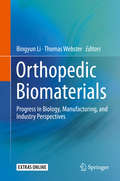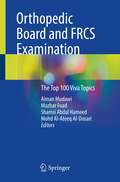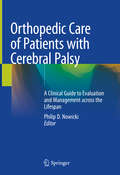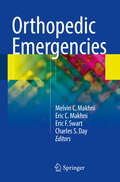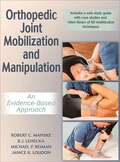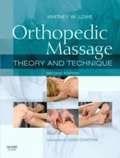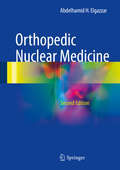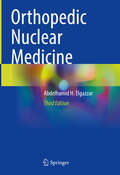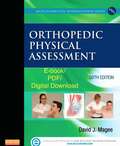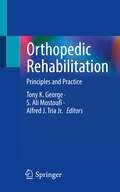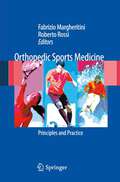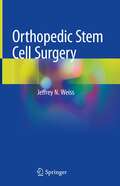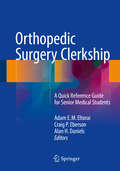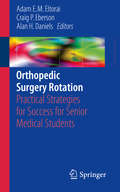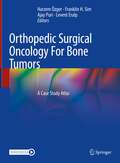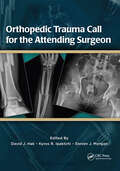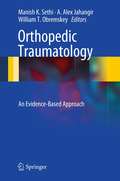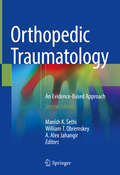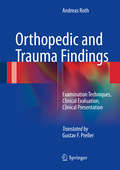- Table View
- List View
Orthopedic Biomaterials: Progress in Biology, Manufacturing, and Industry Perspectives
by Bingyun Li Thomas WebsterThis book covers the latest progress in the biology and manufacturing of orthopedic biomaterials, as well as key industry perspectives. Topics covered include the development of biomaterial-based medical products for orthopedic applications, anti-infection technologies for orthopedic implants, additive manufacturing of orthopedic implants, and more. This is an ideal book for graduate students, researchers and professionals working with orthopedic biomaterials and tissue engineering.This book also:Provides an industry perspective on technologies to prevent orthopedic implant related infectionThoroughly covers how to modulate innate inflammatory reactions in the application of orthopedic biomaterialsDetails the state-of-the-art research on 3D printed porous bone constructs
Orthopedic Board and FRCS Examination: The Top 100 Viva Topics
by Aiman Mudawi Mazhar Fuad Shamsi Abdul Hameed Mohd Al-Ateeq Al-DosariThis book focuses on the precise needs of candidates preparing for the viva part of the FRCS, Int-FRCS, and Orthopaedic Board Examinations. With more than 600 candidates annually sitting for these examinations this volume is meticulously crafted to empower aspiring orthopaedists to excel in it.Structured for effortless comprehension, the book is presented in a reader-friendly format that facilitates effective revision. Entirely written by experts who have successfully navigated these examinations its authorship contributes to make it an invaluable resource for aspirant orthopaedists.This practical yet comprehensive book covers high-yield topics essential for passing the exams while also equipping readers with strategies to confidently address even the most unconventional scenarios they may encounter during vivas. This practical resource provides a structured and unparalleled approach to empower aspiring orthopaedists to excel in the FRCS, Int-FRCS, and Orthopaedic Board Examinations.
Orthopedic Care of Patients with Cerebral Palsy: A Clinical Guide to Evaluation and Management across the Lifespan
by Philip D. NowickiMany of the existing books focusing on the orthopedic management of patients with cerebral palsy encompass only care for the young patient, but this practical text reviews and delineates orthopedic care for patients with cerebral palsy throughout the lifespan. Readers will find a discussion of both non-operative and operative orthopedic management across all ages and functional levels. The text presents a general overview of cerebral palsy, evaluation of patients with cerebral palsy, and procedures commonly used to treat various orthopedic conditions in patients with cerebral palsy. Spasticity management and gait evaluation are likewise highlighted, and surgical chapters cover techniques for the hip, knee, foot and ankle, and spine. It also incorporates chapters focused on issues related to the rehabilitation of patients with cerebral palsy, including bracing, orthotics and other durable medical equipment, physical and occupational therapy, pain management, and adaptive activities and sports, which aim to improve the overall quality of life for patients through the lifespan. Finally, there is a chapter focused on the care transition from childhood to adulthood, an area of importance often neglected in current texts covering patients with cerebral palsy.Whether in the operating room, multi-specialty clinic or private office, Orthopedic Care of Patients with Cerebral Palsy will be a go-to resource for orthopedists, pediatricians and all medical professionals caring for this population.
Orthopedic Emergencies
by Melvin C. Makhni Eric C. Makhni Eric F. Swart Charles S. DayThis book is a one-stop guide to managing acute orthopedic injuries. Unlike other handbooks, this reference provides a comprehensive, yet concise, set of diagnostic and management tools to help readers deliver optimal, evidence-based, and efficient patient care. Additional focus on physical exam techniques, emergency room orthopedic procedures, and on-field athletic management strategies empowers readers with real tips and tricks used by orthopedic surgeons at top-tier institutions. This guide is a must have for emergency medicine providers, orthopedic surgeons, and other clinicians, trainees, and students caring for adult or pediatric patients in the emergency setting.
Orthopedic Emergencies: Expert Management for the Emergency Physician
by Michael C. Bond Andrew D. Perron Michael K. Abraham Michael C. Bond Andrew D. PerronAcute care physicians are frequently faced with diagnosing and treating orthopedic emergencies with limited resources and without immediate specialist availability. Orthopedic Emergencies focuses on the acute management and stabilization of orthopedic injuries with specific recommendations on procedures and the stabilization of fractures and dislocation. The topics are organized anatomically with additional chapters on Procedures, Reduction Techniques, and Immobilization and Splinting. The information needed for a rapid diagnosis is available instantly through the bullet-point-style text, diagrams, images, pearls and pitfalls. There are specific recommendations on which splint to apply and how to position the affected limb, as well as advice on when to arrange follow up with an orthopedist or sports medicine physician. The spiral binding allows the book to lay flat for easy use at the bedside, making Orthopedic Emergencies the ideal companion for all emergency medicine providers including emergency department physicians, sports clinics, family medicine practitioners and mid-level providers.
Orthopedic Emergencies: Expert Management for the Emergency Physician
by Michael C. Bond Andrew D. Perron Michael K. Abraham Michael C. Bond Andrew D. PerronAcute care physicians are frequently faced with diagnosing and treating orthopedic emergencies with limited resources and without immediate specialist availability. Orthopedic Emergencies focuses on the acute management and stabilization of orthopedic injuries with specific recommendations on procedures and the stabilization of fractures and dislocation. The topics are organized anatomically with additional chapters on Procedures, Reduction Techniques, and Immobilization and Splinting. The information needed for a rapid diagnosis is available instantly through the bullet-point-style text, diagrams, images, pearls and pitfalls. There are specific recommendations on which splint to apply and how to position the affected limb, as well as advice on when to arrange follow up with an orthopedist or sports medicine physician. The spiral binding allows the book to lay flat for easy use at the bedside, making Orthopedic Emergencies the ideal companion for all emergency medicine providers including emergency department physicians, sports clinics, family medicine practitioners and mid-level providers.
Orthopedic Joint Mobilization and Manipulation: An Evidence-Based Approach
by Robert C. Manske Janice K. Loudon Michael P. Reiman B. J. LeheckaOrthopedic Joint Mobilization and Manipulation: An Evidence-Based Approach With Web Study Guide is a guide to clinical applications that can provide relief for a wide range of musculoskeletal ailments related to pain, dysfunction, and limited joint mobility. Ideal for physical therapy and athletic training students and professionals, this comprehensive resource provides a clear understanding of how thrust and nonthrust techniques work to eliminate pain and re-establish normal joint motion and function.
Orthopedic Massage: Theory and Technique
by Whitney Lowe Leon ChaitowIntroduction to orthopedic massage, Understanding soft-tissue injuries, Thermal modalities as treatment aids, Introduction to specific massage techniques, Physiological effects, Foot, ankle, and lower leg, Knee and thigh, Hip and pelvis, Lumbar and thoracic spine, Cervical spine, Shoulder, Elbow, forearm, wrist and hand.
Orthopedic Nuclear Medicine
by Abdelhamid H. ElgazzarThis invaluable and well-presented text brings together previously fragmented or incompletely elucidated data on the impressive recent advances in orthopedic nuclear medicine. The book begins by acquainting the readers with various anatomic, physiologic, pathologic and technical concepts crucial to understanding orthopedic nuclear medicine and its utilization in clinical practice. Subsequent chapters detail the diagnosis of skeletal infections, trauma, vascular disorders, metabolic and neoplastic bone diseases, soft tissue calcifications and joint disorders. A separate section is devoted to the use of radionuclides in the treatment of bone and joint diseases. A unique feature of this richly illustrated volume is its comprehensive and clinically oriented approach. The book will prove invaluable to all with an interest in diagnostic and therapeutic orthopedics, including radiologists, orthopedists, rheumatologists, pediatricians, other clinicians and nuclear medicine professionals.
Orthopedic Nuclear Medicine
by Abdelhamid H. ElgazzarThis book, now in its revised and updated third edition, offers a comprehensive overview of the state of the art in orthopedic nuclear medicine, including the impressive recent advances in the field and the diagnosis of under-recognized conditions based on their imaging patterns. The opening chapters acquaint the reader briefly with anatomic, physiologic, pathologic, and technical concepts crucial to a sound understanding of orthopedic nuclear medicine and its utilization in clinical practice. The imaging diagnosis of skeletal infections, trauma, vascular disorders, metabolic and neoplastic bone diseases, soft tissue calcifications, and joint disorders is then explained in detail. New developments in the role of nuclear medicine in the management of bone tumors and particularly, in the diagnosis and treatment of prostate cancer metastases have been added to this new edition. The book is richly illustrated with many newly added figures and illustrations and amply documents the effectiveness of nuclear medicine in diagnosing bone disease. It will prove invaluable to all with an interest in diagnostic and therapeutic orthopedics, including orthopedists, radiologists, rheumatologists, pediatricians, podiatrists, other clinicians, and all nuclear and molecular imaging professionals.
Orthopedic Physical Assessment
by David J. MageeOrthopedic Physical Assessment, 6th Edition provides rationales for various aspects of assessment and covers every joint of the body, as well as specific topics including principles of assessment, gait, posture, the head and face, the amputee, primary care, and emergency sports assessment. Artwork and photos with detailed descriptions of assessments clearly demonstrate assessment methods, tests, and causes of pathology. The text also comes with an array of online learning tools, including video clips demonstrating assessment tests, assessment forms, and more.
Orthopedic Physical Examination Tests: An Evidence-Based Approach
by Chad Cook Eric HegedusThis is the field’s most comprehensive evidence-based guide to clinical tests for orthopedic physical examination. ORTHOPEDIC PHYSICAL EXAMINATION TESTS: AN EVIDENCE-BASED APPROACH, 2/e presents complete explanations and photography visualizing all commonly used physical exam tests for all body regions, including both neurological screening tools and conventional tests. The quality of research supporting each test is assessed using the QUADAS quality instrument, which analyzes the extent to which bias may have influenced diagnostic values. Diagnostic values are reported wherever they exist, and summary “Utility” scores are provided for each test based on the authors’ interpretation of the research and their use of the tests in clinical practice. This edition adds 200 new tests, presents valuable clusters of tests, and contains two entirely new chapters: one on visceral assessment and medical screening, and another on temporomandibular examination.
Orthopedic Practice Management: Strategies for Growth and Success
by Melvin C. Makhni Eric C. Makhni Eric F. Swart Charles A. Bush-JosephThis unique resource provides a solid introduction to practice management for orthopedic practitioners—whether employed in a hospital setting, in private practice, or on faculty at a university setting—and it will be especially valuable to all surgeons still in their residency, providing valuable insight into how to best prepare to effectively care for patients. Orthopedists both domestic and international will benefit immensely from its contents, skills that are often overlooked in medical training. Part one presents the essentials of starting and building a practice, including strategic, personal and legal considerations, partnerships and ancillaries, keys for growth and success, incorporating mid-level providers, and the use of social media. Leadership and management are covered in part two, discussing the management of a private practice and a privademic medical center, recruitment and expansion, outcome collections, the pursuit of a dual degree, and all-important healthcare policy. Additional relevant topics are presented in part three, including surgical training and education, independent medical exams and legal depositions, board certification and maintenance, principles of clinical research, and surgical innovation. In today’s ever-changing healthcare climate, practitioners must know how to deliver the medicine they spent so many years learning and perfecting. Orthopedic Practice Management is the first text dedicated to teaching surgeons the essential non-clinical fundamentals for succeeding in healthcare. No matter what stage of practice you are in—from student to master surgeon—you will find that this book contains invaluable information for achieving success in orthopedics.
Orthopedic Rehabilitation: Principles and Practice
by Alfred J. Tria S. Ali Mostoufi Tony K. GeorgeThis pocket-sized guide provides a practical and comprehensive resource for orthopedic, PM&R, and musculoskeletal specialists, as well as primary care physicians who work in the community outpatient clinic setting. Its consistent chapter format covers each area with anatomy, physical examination, preoperative management, and postoperative rehabilitation sections for the spine and extremities. The book presents treatment protocols for various injuries, including physical therapy measures such as weight bearing status, PRE, closed or open chain exercises, and timing for returning to routine or sport activities. Its concise presentation of rehabilitation for the upper and lower extremities, the hip and pelvis, and the spine enables quick reference and clinical decision-making. Furthermore, the book includes a chapter on rehabilitation following the use of orthobiologics, making it a valuable resource for healthcare professionals involved in orthopedic rehabilitation after regenerative interventions.
Orthopedic Residency and Fellowship: A Guide to Success
by Kenneth Egol Joseph Zuckerman Laith JazrawiOrthopedic surgery remains one of the most competitive subspecialties in medicine. This “how- to” guide describes how medical students can achieve their goal of being accepted into an orthopedic residency program and how to thrive once there.What will you learn from Orthopedic Residency and Fellowship: A Guide to Success?• How medical students can achieve their goal of being accepted into an orthopedic residency program• How to succeed during and after your residency• Tips and pearls to maximize your experience• Budgeting your time• Peer interaction• Job placement• How to read a contract• How to decide between academic or private practice• Asset protection • Making the right financial decisionOrthopedic Residency and Fellowship: A Guide to Success by Drs. Laith M. Jazrawi, Kenneth A. Egol and Joseph D. Zuckerman is the only book on the market that solely focuses on getting into an orthopedic residency or fellowship training program, excelling once you are there, and maximizing and obtaining the right practice opportunity for you. Providing easy-to-read chapters and quick reference materials, this book is a must-read for anyone interested in the field of musculoskeletal care.
Orthopedic Sports Medicine
by Roberto Rossi Fabrizio MargheritiniAim of this book is to give an update on the main issues in sports traumatology and orthopedics, involving different body sections. Exploring the most important aspects of sports medicine - from anatomy to normal movements description, from diagnosis to sports injuries treatment, from conservative to surgical treatments - it gives a global overview of the field, describing also diagnostic tools recently introduced in this field, such as hip arthroscopy, and taking into consideration related areas like nutrition, prevention, training and rehabilitation. The single chapters deal with relevant problems such as emergencies on the field, pathologies of the upper and lower extremity, spine problems in athletes. Each injury is approached on the basis of both the specific body area and of the different sports/activities. Written by a multidisciplinary team of experts, this volume will be a fundamental book for orthopedic surgeons, physiotherapists, general practitioners, personal and athletic trainers, offering them a useful tool for the management of most frequent injuries in sports medicine.
Orthopedic Stem Cell Surgery
by Jeffrey N. WeissThis book is a concise guide that provides an easy to follow template for other physicians to develop similar stem cell based treatments within their specialty. It identifies and summarizes the current world-wide orthopedic stem cell trials. Organized into three sections, Orthopedic Stem Cell Surgery presents clinical studies that examine the procedures for setting up and implementing stem cell surgery within the specialty of orthopedics. Chapters maintain an accessible narrative while also addressing complex studies related to orthopedic stem cell surgery. A sister text to the recently published, Retinal and Optic Nerve Stem Cell Surgery, and Neurologic Stem Cell Surgery this expertly written book examines critical Institutional Review Board (IRB) approved studies.
Orthopedic Stem Cell Surgery
by Jeffrey N. WeissThis book is a concise guide that provides an easy to follow template for other physicians to develop similar stem cell based treatments within their specialty. It identifies and summarizes the current world-wide orthopedic stem cell trials. Organized into three sections, Orthopedic Stem Cell Surgery presents clinical studies that examine the procedures for setting up and implementing stem cell surgery within the specialty of orthopedics. Chapters maintain an accessible narrative while also addressing complex studies related to orthopedic stem cell surgery. A sister text to the recently published, Retinal and Optic Nerve Stem Cell Surgery, and Neurologic Stem Cell Surgery this expertly written book examines critical Institutional Review Board (IRB) approved studies.
Orthopedic Surgery Clerkship
by Adam E. M. Eltorai Craig P. Eberson Alan H. DanielsThis quick-reference guide is the first book written specifically for the many third- and fourth-year medical students rotating on an orthopedic surgery service. Organized anatomically, it focuses on the diagnosis and management of the most common pathologic entities. Each chapter covers history, physical examination, imaging, and common diagnoses. For each diagnosis, the book sets out the typical presentation, options for non-operative and operative management, and expected outcomes. Chapters include key illustrations, quick-reference charts, tables, diagrams, and bulleted lists. Each chapter is co-authored by a senior resident or fellow and an established academic physician and is concise enough to be read in two or three hours. Students can read the text from cover to cover to gain a general foundation of knowledge that can be built upon when they begin their rotation, then use specific chapters to review a sub-specialty before starting a new rotation or seeing a patient with a sub-specialty attending. Practical and user-friendly, Orthopedic Surgery Clerkship is the ideal, on-the-spot resource for medical students and practitioners seeking fast facts on diagnosis and management. Its bullet-pointed outline format makes it a perfect quick-reference, and its content breadth covers the most commonly encountered orthopedic problems in practice.
Orthopedic Surgery Rotation
by Adam E. M. Eltorai Craig P. Eberson Alan H. DanielsThe 4th year of medical school represents an important transition with new goals and expectations. Matching into orthopedic surgery residency is increasingly competitive. Performing well on orthopedic surgery rotations during the 4th year of medical school is critical for match success. The goal of this guide book is to help students ace their orthopedic rotations. Orthopedic Surgery Rotation focuses on practical tips for success from optimal study resources, key technical skills, and strategies for being a standout orthopedic team player. Each chapter is written by current orthopedic residents, who not only know from personal experience on how to excel but also are actively involved in evaluating the performance of 4th year medical students. This book will serve as tool to propel students to the next level and help them start their journey as orthopedists on the right foot.
Orthopedic Surgical Oncology For Bone Tumors: A Case Study Atlas
by Levent Eralp Franklin H. Sim Harzem Özger Ajay PuriThis atlas presents a collection of richly illustrated teaching cases. It covers the fundamentals of orthopedic oncology complemented with relevant aspects that are demonstrated using individual cases. In a specialty that deals with a relatively smaller number of cases compared to tumors of other systems, this atlas prepares readers for clinical practice by combining a problem-based learning (PBL) approach, which lies on the continuum between structured and guided learning, with theory and practical insights.The book is divided into sections, arranged according to anatomical regions and the reconstruction type. Each section focuses on a specific anatomical region, and each case presentation includes the basic clinical history, basic principles, preoperative, perioperative and radiographic images, a pitfall list, treatment strategy, technical pearls, outcomes and complications. For each region the authors discuss both the biological and non-biological reconstruction techniques. The book is designed to actively involve the reader, making it an invaluable tool for all orthopedic surgeons confronted with oncologic surgery. The book is intended for trainees in orthopedics, orthopedic oncology fellows as well as practicing consultants.
Orthopedic Trauma Call for the Attending Surgeon
by Steven Morgan David Hak Kyros IpaktchiOrthopedic Trauma Call for the Attending Surgeon is a clinically focused book that will help guide the orthopedic surgeon through the most commonly encountered injuries when on call.Drs. David J. Hak, Kyros R. Ipaktchi and Steven Morgan are joined by over 50 leading experts to provide a succinct and quick review of the key points that will allow you to provide patients with expert and immediate care.Inside Orthopedic Trauma Call for the Attending Surgeon each chapter is written in an easy to read bulleted format that will allow for a quick review of the key facts you need to know while taking call. Chapters also cover emergent and definitive management and provide guidelines for when to consider referral to a higher level of care. The authors also share their tips and tricks for successful outcomes, while highlighting potential pitfalls and how to avoid them. Since it can be difficult to find time to read a traditional textbook or review article, Orthopedic Trauma Call for the Attending Surgeon is perfect for orthopedic surgeons, physician assistants, extenders who cover ER call, and orthopedic trainees.
Orthopedic Traumatology
by William T. Obremskey Manish K. Sethi A. Alex JahangirPhysicians are under increasing pressure to provide quality health care in the most cost-effective way possible. The escalating costs of orthopedic care are driving the need to base clinical decision making on evidence-based data that will help physicians provide optimal care to every patient. Evidence-based medicine is the future of orthopedic surgery. In a world where the quality of surgical outcomes will be increasingly measured, evidence-based data will heavily guide decision making in orthopedic trauma. Orthopedic Traumatology: An Evidence-Based Approach provides the reader with a focused and comprehensive review of the literature surrounding the management of the orthopedic trauma patient. The book centers around clinical scenarios with each chapter based on a specific case. Renowned orthopedic trauma surgeons from across the country serve as contributing authors, writing based on these scenarios and giving their expert opinions on management while using data as their guide. Each chapter describes and summarizes the data, but achieves this objective in a case-based format. Each case is brief, but includes relevant imaging. The case scenarios are heavily weighted toward treatment of more controversial injuries. As there is currently no book on the market that focuses solely on orthopedic trauma and evidence-based medicine, this book is sure to be a useful reference for residents and practicing physicians alike.
Orthopedic Traumatology: An Evidence-based Approach
by William T. Obremskey Manish K. Sethi A. Alex JahangirNow in its revised and expanded second edition, this comprehensive, user-friendly text brings the latest evidence to bear on the diagnosis and management of orthopedic trauma patients. Centering on clinical scenarios, each chapter is based on a specific case. Leaders in the field of orthopedic trauma provide their expert opinions on management strategies and techniques while using data as their guide. The book is divided into sections covering the spine, upper and lower extremities, hip and acetabulum, foot and ankle, polytrauma, infection and perioperative management. New chapters in this edition discuss elbow fracture dislocations, femoral neck fractures in the young, Lisfranc injuries and acute post-operative infection. Each chapter describes and summarizes the data in a consistent structure, but achieves this objective in a case-based format.Utilizing the latest literature, Orthopedic Traumatology: An Evidence-Based Approach, Second Edition will continue to serve as a guide for orthopedic residents and practicing physicians alike.
Orthopedic and Trauma Findings
by Andreas RothThis book is a practical, step-by-step guide to orthopedic examination and diagnosis. The author explains a systematic classification of clinical findings that has proven very useful in diagnosing orthopedic disorders in daily routine. The approach to examination begins with a checklist covering the complete patient history, including subjective descriptions of complaints. This is followed by a stepwise approach to physical examination of the patient and collection of clinical findings. Photographs and illustrations clearly depict the necessary examination techniques. The main symptoms are then determined from the patient history and clinical findings, leading to a diagnosis. An overview of all relevant orthopedic conditions for each region of the body facilitates differential diagnosis and thereby completes the examination findings. This book will be of particular value for new residents in orthopedics and trauma but will also be useful for the experienced physician as a means of refreshing knowledge or as a reference.
